Kurt Alder was a German chemist who won the 1950 Nobel Prize in chemistry for inventing a method for synthesizing organic compounds. This reaction is referred to as the ‘Diels-Alder reaction’ or ‘diene synthesis’. He shared the prize with another German chemist, Otto Diels, who accompanied him to the University of Kiel to conduct the experiment. The process enabled the development of synthetic rubber, alkaloids, plastics, dyes, drugs, drying oils, lubricating oils, and other previously unavailable organic compounds. The primary feature of this process was that it did not require catalysts or reagents and did not require the application of high temperatures or pressures to accomplish the task. The cost of producing the synthetic organic compounds was extremely low. Though numerous other scientists had previously asserted this phenomenon, it was Alder and Diels who established the reaction’s experimental validity and demonstrated its application in the production of a wide variety of synthetic compounds such as cortisone, morphine, and reserpine. This process can also be used to synthesize steroids, polymers, and alkaloids, as well as insecticides such as dieldrin and aldrin. He published numerous papers demonstrating how completely new compounds can be synthesized from existing ones.
Childhood & Adolescence
Kurt Alder was born on July 10, 1902 in Konigshutte, Upper Silesia, Prussia, now known as Chorzow, Poland. His father, Joseph Alder, was a teacher at a Kattowitz school. Kurt grew up in Konigshutte’s industrial environment.
His early education was completed in Konigshutte’s German schools. His family relocated to Germany following the end of World War I in order to retain their German citizenship when the area in which they lived was annexed by Poland.
After graduating from Berlin’s Oberrealschule, he studied chemistry from 1922 to 1923 at the University of Berlin and later at the University of Kiel. In 1926, he earned a doctorate from Kiel University.
Career of Kurt
Kurt Alder began his career as a research scholar at the University of Kiel’s Otto Diels laboratory following his doctorate.
In 1928, while collaborating with Diels on the structure of organic compounds, he discovered a method for transforming a simple ‘diene’ compound such as ‘butadiene’ into a complex one.
This process, dubbed the ‘Diels-Alder reaction,’ was instrumental in the development of synthetic plastics, rubber, alkaloids, insecticides, and a variety of other synthetic organic compounds.
During this time, he collaborated with a number of younger laboratory colleagues on experiments involving stereochemical reactions, particularly those involving unsaturated systems. He also conducted experiments on the behavior of double bonds in carbon rings and the formation of intermolecular arrangements.
He was appointed Reader in 1930 and promoted to professor in 1934 at the University of Kiel’s Department of Organic Chemistry. He served in this capacity until 1936.
In 1936, he was appointed research director of Bayer Werker, a branch of the world’s largest chemical company, I. G.
Farbenindustrie, in Leverkusen. He applied his theory to the development of plastics and also devised methods for the production of synthetic rubber known as ‘Buna’.
In 1938, he was elected to the ‘Kaiserlich Leopold Karol Deutschen Akademie der Naturforscher’ or ‘Imperial Leopold Karol Academy of Natural Philosophers’ in Halle.
His old desire to conduct additional research was rekindled during his work with I. G. Farbenidustrie, and he returned to academia in 1940. He was appointed director and professor in the department of ‘Experimental Chemistry and Chemical Technology’ at the ‘University of Cologne’s Chemical Institute. He held this position until his death in 1958.
Despite the fact that the work environment in Cologne was unsuitable for scientific research during this time period, Alder continued to conduct research on organic compounds. These experiments ranged from simple additive processes such as ‘diene synthesis’ to more complex substitution processes. Additionally, he conducted experiments on the reactions of molecular oxygen with unsaturated compounds.
He discovered the ‘ene reaction’ in 1943, which was very similar to the ‘diene synthesis’ process. This technique is also widely used in the field of chemical synthesis.
Between 1949 and 1950, he served as Dean of the Faculty of Philosophy. When he was awarded the Nobel Prize in 1950, he was affiliated with the University of Cologne.
Significant Works of Kurt
Kurt Alder’s doctoral dissertation was titled ‘Über die Ursachen der Azoester-reaktion’ or ‘On the Causes of the Azoester Reaction.’
The majority of his publications were in scientific journals such as ‘Angewandte Chemie,’ ‘Berichte der Deutschen Chemisen Gesellschaft,’ and ‘Justus Liebig’s Annalen der Chemie.
Awards and Accomplishments
Kurt Alder was awarded the Emil Fischer Memorial Medal by the German Chemists Association in 1938. In 1950, he shared the Nobel Prize in chemistry with Otto Diels for the ‘Diels-Alder reaction.’
In 1950, he was also awarded an honorary M.D. degree by the University of Cologne. In 1954, the University of Salamanca bestowed upon him an honorary doctorate.
Personal History and Legacies
On March 10, 1948, he married Irene Hawthorne, a prima ballerina. On September 16, 1965, he married Christiane Tocco. Kurt Alder died on June 20, 1958, in Cologne, West Germany.
Humanitarian Action of Kurt
He was committed to world peace, and in 1951, he joined a group of seventeen other Nobel laureates in issuing an appeal to all nations, urging them to abstain from war with other nations.
Estimated Net Worth
Kurt is one of the wealthiest chemists and is listed on the list of the most popular chemists. Kurt Alder’s net worth is estimated to be around $15 million, based on our analysis of Wikipedia, Forbes, and Business Insider.
Trivia
Kurt Alder lost both of his parents during World War II when they were apprehended by the Gestapo for being Jews.


